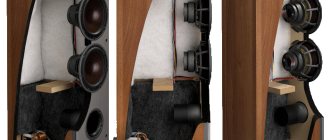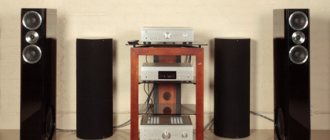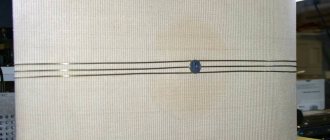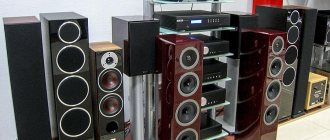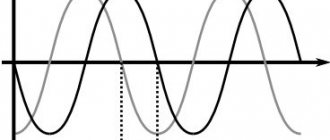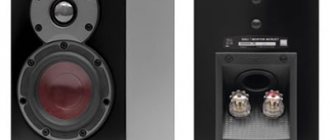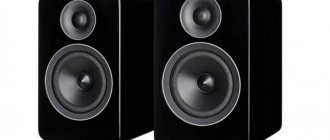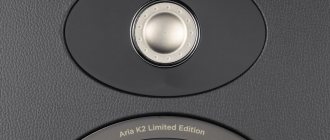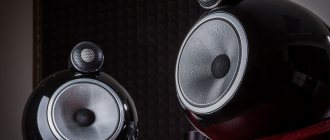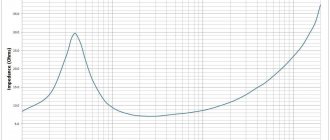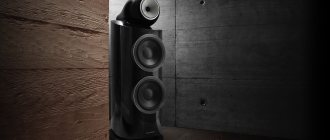The three-way floorstanding speaker B&W Diamond 802 D3 is currently the senior speaker in the completely updated Diamond series.
The body of the model has a Matrix frame calculated using computer modeling with durable plywood stiffeners and metal elements. The frame smoothly wraps around the front and sides with one sheet of plywood and tapers to the rear, made of aluminum. This rigid platform provides effective damping, while the curved lines solve problems associated with standing waves and diffraction. A Flowport bass reflex is built into the bottom of the cabinet, reducing turbulence in the air flow.
At the top of the body there is a “turbine head” - a drop-shaped aluminum module with a 150 mm midrange driver equipped with a new Continuum diffuser. The internal part of the module is reinforced with stiffening ribs to achieve maximum inertness. This “head” also improves dispersion characteristics and dampens waves emitted by the back side of the membrane. A 25 mm conical aluminum tweeter tube with a lightweight diamond membrane is attached to the top of the Turbine head. The membrane has exceptional hardness, has a break frequency of 70 kHz and is manufactured by chemical vapor deposition. The tweeter delivers precise, crystal-clear sound and extends the top end of the frequency range to 35 kHz, while its tube provides effective damping.
The Continuum cone is not made of Kevlar, as before, but of a special woven composite material with a special coating that copes more effectively with parasitic resonances. The diaphragm has a fixed FST suspension, which reduces its response time and increases the accuracy of sound transmission.
The B&W Diamond 802 D3 features dual 200mm woofers with a rigid, lightweight Aerofoil cone that is unequal in thickness for increased strength in specific areas, promoting more linear piston motion and preventing flex. The diffusers are made from a combination of syntactic foam, carbon fiber and other materials.
The rear of the case has 4 screw terminals for dual-cable connections, and its 17 kg aluminum base integrates retractable spikes and rollers that allow you to easily move the speaker. Crossover filters use selected components.
The B&W Diamond 802 D3 delivers exemplary sound with exemplary tonal balance, plenty of detail, airy highs, natural mid-range presentation, deep, accurate bass and expansive 3D imaging.
Characteristics of floor-standing acoustics B&W Diamond 802 D3
| Number of lanes | 3 |
| Number of speakers | 4 |
| Type of shell | bass reflex Matrix, Flowport installed in the bottom of the cabinet |
| Tweeter type | 25mm diamond dome tweeter housed in a conical aluminum tube |
| Diameter and type of midrange driver | 150 mm midrange driver with Continuum cone made of woven composite material with a special coating and FST technology, housed in a teardrop-shaped inert aluminum module |
| Diameter and type of LF emitter | 2 x 200 mm LF drivers, Aerofoil diffuser is made of a special material and has different thicknesses, powerful magnetic system |
| Frequency response | 17 Hz – 28 kHz (+/- 3 dB) |
| Sensitivity | 90 dB (2.83 V) |
| Harmonic distortion (2nd and 3rd harmonics, 90 dB, 1 m) | less than 1% (80 Hz – 20 kHz), less than 0.3% (100 Hz – 20 kHz) |
| Impedance | 8 ohms, minimum: 3 ohms |
| Recommended amplifier power | 50 W – 500 W per channel at 8 ohms |
| Max. recommended cable resistance | 0.1 ohm |
| Input Connectors | 2 pairs of screw terminals |
| Grill mount | magnetic |
| Dimensions (WxHxD) | 390x1212x583 mm |
| Weight | 94.5 kg |
Fine Cut. Acoustics test B&W 802 Diamond
As you know, any, even the most perfect artificial sound is inferior to live music. At the same time, some rare audio components, born from the union of a fruitful tradition and advanced technical thought, are capable of demonstrating the phenomenon of almost complete merging of a copy with the original - the most precise cut of sound. This is the B&W 802 Diamond - a real High End. Top End.
In audio, tradition and continuity are important. The achievements of the British company are milestones in the history of the famous 800 series. In 1979, the first such model was released: Matrix 801. Subsequent incarnations of the 800s are steps up the quality ladder, stages in the service of high musical fidelity, “hooks driven into the sheer rock of precision” (Nabokov). A few years ago, Bowers & Wilkins equipped the speakers with a diamond diaphragm tweeter. As the name of the modern 800 Diamond Series suggests, the diamond still shines in the crown of the queen of British acoustics. The B&W diamond dome tweeter is now used in all loudspeaker systems in the family. Based on familiarity with many B&W speakers, it can be argued that this driver is one of the best in the history of audio: only the Focal head with an inverted beryllium membrane and, possibly, the Danish Ring Radiator can keep it company.
In profile, the acoustics reveal another of their secrets - Nautilus technology; the tweeter, in particular, is topped with a long tube that dampens the back radiation of the dome.
In terms of a set of important sound features - lightness, accuracy and neutrality of sound - the B&W speaker is not inferior to the best transducers of other types: electrostatic and even ionophone. B&W engineers proudly talk about the dynamics, the technology of forming a dome by depositing the finest diamond dust on a substrate. When asked about the place of production of “jewelry” domes, they answer evasively, and sometimes with humor. For example, in England I was told that the diaphragms were made in Windsor. Could it be in the apartments of the royal palace? The British company claims that the 800s have long been a “legend in recording studios,” and there is obviously a lot of truth to those words. I saw the 800s in the control rooms of Abbey Road Studios in London, and recently came across these speakers (albeit of the previous generation) in the sound engineer's room in the Great Hall of the Moscow Conservatory. I.P. Veprintsev, with whom I talked there (interview in the April and May issues of S&V), spoke about trusting the 800s, spoke of them as worthy and very accurate sound instruments. A few months ago, S&V wrote about the youngest model of the B&W “diamond” family: 805 Diamond. Today on the test bench is the 802 Diamond model, standing in the corporate hierarchy one step below the top system in the line: 800 Diamond. Structurally, the 802 is identical to the 800. In essence, the 802 offers the same quality as the 800, but in slightly smaller quantities: the general configurations of the speakers are the same, but the 802 has smaller dimensions (it is 4.5 cm lower), weight (significantly lighter - 30 kg), different low-frequency equipment (a pair of 200 mm woofers versus a pair of 250 mm) and amplifier power range (50–500 W versus 50–1000 W). The 802 is the quintessential achievement of B&W. In addition to diamond tweeters, other technologies that we have repeatedly mentioned in other articles are also implemented here. Nautilus load tubes suppress rear radiation from the tweeter diaphragm. Kevlar (B&W turned to it in the mid-1970s and during that time gained extensive experience in its use), FST technology and spherical acoustic design guarantee exceptionally accurate midrange transmission. Thanks to the FlowPort bass reflex channel with grooves on the surface of the tube, like a golf ball, anyone will have difficulty hearing the breathing of the port at the bottom end of the speaker. The high quality of the speakers made it possible to minimize electronic filtering, which, by the way, was implemented on a high-quality element base (M Cap capacitors, etc.). I don't think there's any need to continue.
The acoustics form pictures that seem to be life-size, without scaling anything.
Well, what about the sound? The story about the sound of high-end audio components - and this is exactly what the B&W 802 Diamond is - naturally flows and slides into a story about music. Listening to the speakers, you experience the different music they transmit with rare fullness and intensity. Sometimes it seems that acoustics do not just play or sound, but, like a talented painter, confidently and at the same time carefully apply fresh, clean and vibrating colors onto a smooth sound canvas, which is absolute silence. Sounds and images seem to grow out of silence and plunge into it. In the musical style of B&W there is nothing introduced, nothing superfluous, nothing that would prevent the complex musical architecture from appearing in perfect clarity - both its entire skeleton and the most delicate and subtle structures. And what an endless dynamic space - from perfectly legible micro-details to uncompromising big-time play! Playing orchestral, organ, etc. material that requires great sound and full frequency coverage, the acoustics form pictures that seem to be life-size, without scaling anything, without crushing anything or violating proportions, and evenly broadcasts the entire frequency spectrum - from the infrabass “underworld” to the high-frequency stratosphere. B&W is a household name, as they say.
Rollers can serve as support for the acoustic system. They are very convenient because... make it easy to move heavy speakers while experimenting with their placement.
Sometimes you think whether we hear it too often, and you involuntarily resist what you hear, thinking and sometimes saying something like this: so what are these B&W? What's so special about them? But still, dear reader, we must pay tribute to these works of engineering art and, at the same time, actually amazing musical instruments. All its technologies, which everyone has heard a lot about: Nautilus, Kevlar, Matrix, etc., are aimed at preserving and presenting valuable grains of sound, and since there are a lot of these grains, together they give the sound a special musical dimension. After all, this is truly the highest class, outstanding technology! I invite everyone to listen to the B&W 802 Diamond to make sure of this.
The frequency response registers small fluctuations (unevenness in the band 100 Hz - 20 kHz 2.4 dB), which do not disturb the musical tonal balance. The gentle slope on the left side of the graph gives a low cutoff frequency: 30 Hz. The directionality of the sound is moderate and manifests itself in the mid/high frequency region. The relief of the angular frequency response coincides, i.e. reflected sound is spectrally close to direct sound. Graphs of SOI versus signal frequency and amplitude indicate a very wide dynamic range. The lower case is very dynamic. In the range of 40–100 Hz, the difference between the minimum and maximum SOI values when the volume is doubled and quadrupled is 0.8%. Above 40 Hz the level of nonlinearity is very low. The model is stable as electrical resistance: RMS 5.1 Ohm, minimum 3.1 Ohm is not dangerous for most modern amplifiers, the average value is close to the nominal resistance value. The speaker system slightly stretches the square pulse; It can be seen that the MF/HF and LF emitters are switched on in different acoustic polarities.
Text: Artyom Avatinyan
Speaker system Bowers & Wilkins 802 D3 Satin White
The 800 Diamond Series from Bowers & Wilkins has raised the bar for high-end loudspeaker performance to unprecedented heights. For nearly 40 years, generation after generation, Bowers & Wilkins 800 Series speakers have set the standard for performance for other speakers that try to follow them. Today, on the eve of the company's 50th anniversary, the new 800 Diamond Series pushes the boundaries of what's possible in hi-fi loudspeakers. The 800 Diamond Series is the result of a seven-year research project to make the best speakers even better. The combination of tireless research and development, cutting-edge technology and countless hours of listening with the best ears in our industry has resulted in a family of loudspeaker systems that bring the listener closer to the original recording than was previously thought possible. This is a fundamental evolution of the line, with almost every component different from the previous 800 Diamond Series. As Bowers & Wilkins research team leader Martial Rousseau said: “This is not just a product update. This is a completely revised line. One of the few remaining elements from the previous series is the diamond tweeter. We realized that it was impossible to improve the sound of a diamond dome.”
Apart from the exceptional diamond tweeter, the rest of the speaker system has been ruthlessly redesigned from the ground up to achieve uncompromising sound that sets a new benchmark in speaker technology. The changes include a huge number of technological, engineering and acoustic innovations combined to create a sophisticated listening experience. The most striking thing was the transformation of the mid-range speaker. The new Continuum cone, with superior acoustic performance, replaces Kevlar, which for many years was the key to the incredibly realistic midrange sound of the 800 Series speakers. Bass quality has also been dramatically improved, thanks to the creation of Aerofoil diffusers with a new profile that significantly reduces distortion. Thanks to these innovations, combined with improved enclosures, a stiffer Matrix internal fin system, a new beefier cabinet tweeter and a vastly improved midrange turbine head, the new 800 Diamond Series is today's nirvana of reference sound quality.
The Bowers & Wilkins Diamond 802 D3 features a computer-designed Matrix frame with durable plywood ribs and metal components. The frame smoothly wraps around the front and sides with one sheet of plywood and tapers to the rear, made of aluminum. This rigid platform provides effective damping, while the curved lines solve problems associated with standing waves and diffraction. A Flowport bass reflex is built into the bottom of the cabinet, reducing turbulence in the air flow. At the top of the Bowers & Wilkins Diamond 802 D3 body is a “Turbine head” - a teardrop-shaped aluminum module with a 150 mm midrange driver equipped with a new Continuum diffuser. The internal part of the module is reinforced with stiffening ribs to achieve maximum inertness. This “head” also improves dispersion characteristics and dampens waves emitted by the back side of the membrane. A 25 mm conical aluminum tweeter tube with a lightweight diamond membrane is attached to the top of the Turbine head. The membrane has exceptional hardness, has a break frequency of 70 kHz and is manufactured by chemical vapor deposition. The tweeter delivers precise, crystal-clear sound and extends the top end of the frequency range to 35 kHz, while its tube provides effective damping.
The Continuum cone is not made of Kevlar, as before, but of a special woven composite material with a special coating that copes more effectively with parasitic resonances. The diaphragm has a fixed FST suspension, which reduces its response time and increases the accuracy of sound transmission. The Bowers & Wilkins Diamond 802 D3 features dual 200mm woofers with a rigid, lightweight Aerofoil cone that is unequal in thickness for increased strength in specific areas, promoting more linear piston motion and preventing flex. The diffusers are made from a combination of syntactic foam, carbon fiber and other materials. The rear of the case has 4 screw terminals for dual-cable connections, and its 17 kg aluminum base integrates retractable spikes and rollers that allow you to easily move the speaker. Crossover filters use selected components. The Bowers & Wilkins Diamond 802 D3 delivers exemplary sound with reference-level tonal balance, plenty of detail, airy highs, natural mid-range presentation, deep, accurate bass and expansive 3D imaging. Characteristics of Bowers & Wilkins Diamond 802 D3
Number of bands 3 Number of speakers 4 Housing type bass reflex Matrix, Flowport installed in the bottom of the cabinet Tweeter type 25 mm tweeter with a dome diamond membrane, placed in a conical aluminum tube Diameter and type of midrange driver 150 mm Midrange driver with Continuum diffuser made of woven composite material with a special coating and FST technology, placed in a drop-shaped inert aluminum module Diameter and type of LF driver 2 x 200 mm LF driver, Aerofoil diffuser made of a special material and has different thicknesses, powerful magnetic system Frequency response 17 Hz – 28 kHz (+/- 3 dB) Sensitivity 90 dB (2.83 V) Harmonic distortion (2nd and 3rd harmonics, 90 dB, 1 m) less than 1% (80 Hz – 20 kHz), less than 0.3% (100 Hz - 20 kHz) Impedance 8 ohms, minimum: 3 ohms Recommended amplifier power 50 W - 500 W per channel at 8 ohms Max. recommended cable resistance 0.1 Ohm Input connectors 2 pairs of screw terminals Magnetic grill mount Dimensions (WxHxD) 390x1212x583 mm Weight 94.5 kg

